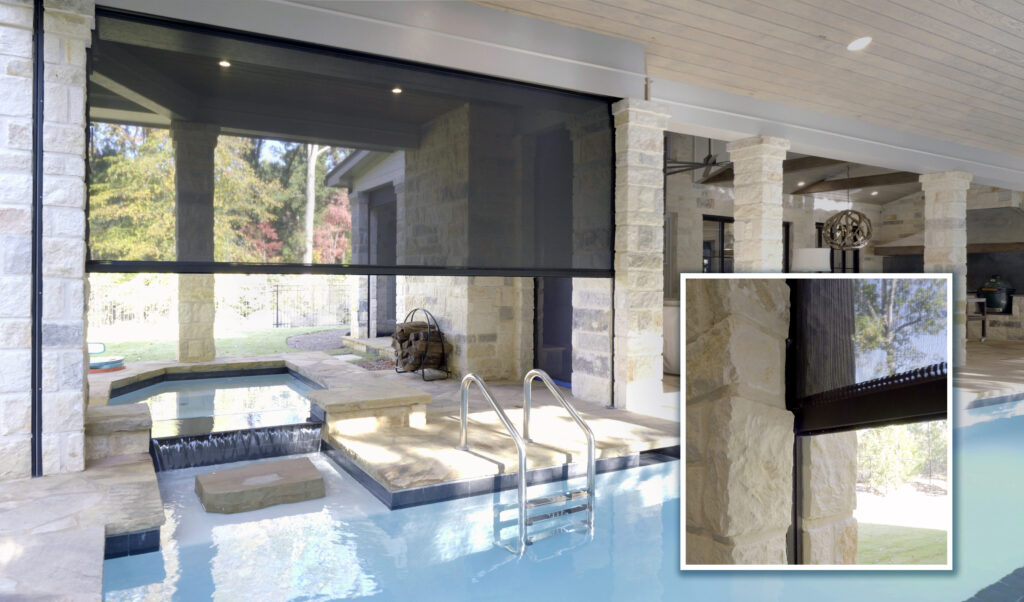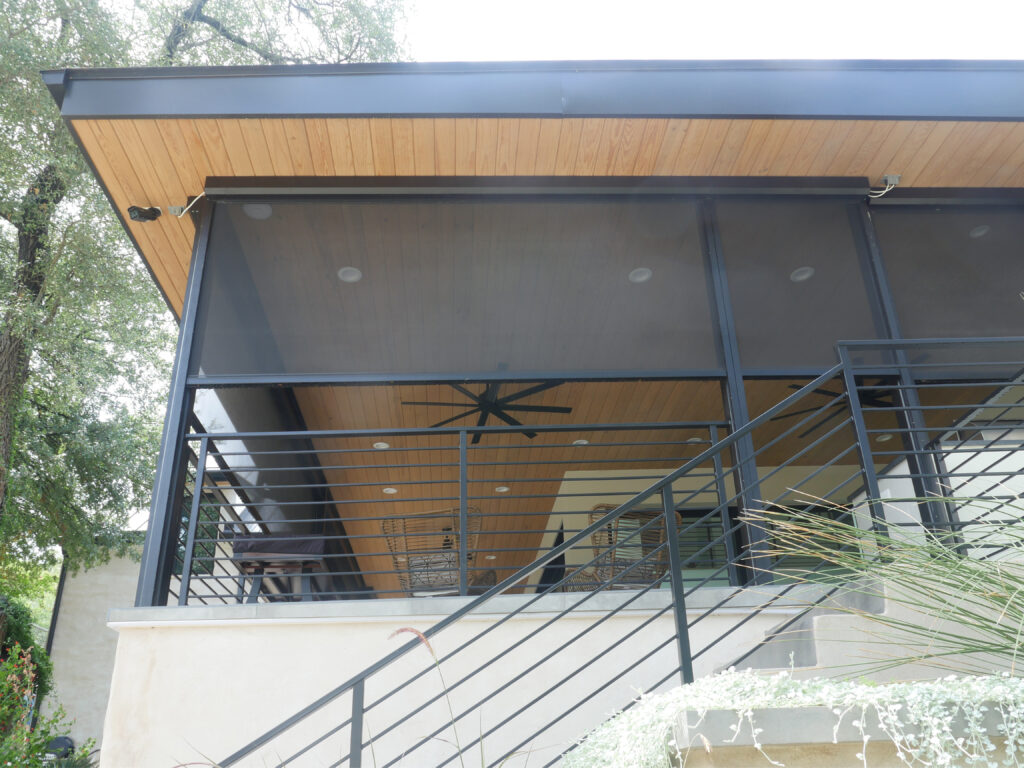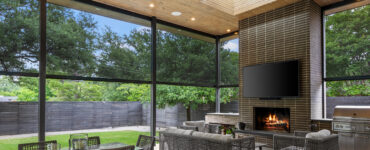
Exterior shading represents a new way to add value to projects and increase your company’s profitability. It might seem a daunting task to take on a new type of shading business, but with the right preparation and approach, the rewards will be worth it.
To Find Opportunities, Think and Talk Differently
How do you currently sell clients on the value of interior shading? You probably talk about heat and glare control and aesthetic enhancement, among other things. And while those are advantages of outdoor shading, the real selling point is the value of creating additional comfortable living space. Present outdoor shading as an opportunity to add a room or rooms to the home’s living area.
In addition to glare and temperature control, outdoor shades provide protection from wind and bugs. Controls for integration allow the homeowner to use shades to make their outdoor living space suit the moment, whether entertaining family and friends, relaxing and enjoying the outdoors in comfort or even creating a private outdoor workspace.
Some of the best opportunities for outdoor shading are:
- Covered patios/porches
- Pergola structures
- Gazebos
- Attaching to the main structure of the house
- Passive cooling for homes
Seeing and selling the value of providing comfort to outdoor spaces will be your road to success.
Addressing Misconceptions Prospective Clients Might Hold
There are some common misconceptions about exterior shading. However, those misconceptions are easy to overcome with the right information and approach.
- Only for moderate or warm climates: Exterior shades are very useful in many different climates. During cold weather, they keep out snow and, with the help of heaters, people can often enjoy their outdoor spaces year-round. And even in moderate climates they can keep rain from interfering with outdoor activities and provide privacy while still allowing a view through to nature.
- Short selling season: While the big installation season for exterior shades runs from spring through autumn, because they provide year-round benefits you can always be talking about and selling outdoor shading solutions.
- The climate is too harsh: In circumstances where certain parts of the year present harsh conditions, quality exterior shading systems are built to handle elements and play an important role in adding functional, comfortable living space. With outdoor shading systems, people can extend the use of outdoor spaces well beyond the time frame they could previously.
- Won’t last long: Quality exterior shading systems are built to last. Metal parts, durable construction and wind tunnel testing are evidence of a system’s ability to last.
Risks and Considerations for Exterior Shades
As with any home improvement, there are a number of risks and details to consider when selling the appropriate product and planning for installation.
- Getting the product to the site: Do you have an appropriate mode of transport to deal with long boxes, skids, ladders and other equipment needed for the project?
- Labor: Exterior shades typically require two or three people for installation, with one to four hours needed per shade.
- Quality of structure: Is the structure strong enough to support the shading system? You’ll also need to ensure installers are provided with the appropriate mounting screws for the supporting beams and structure.
- Firring: Have firring strips been used to level surfaces? Make sure the mounting hardware can get solid support.
- Aftermarket versus new construction: New construction requires planning and coordination with the builder to ensure proper support and space for the shade hardware. Installing an existing structure may require creative workarounds to create a perfect installation.
- Face/Inside/Built-ins: In most applications, face mount applications are the easiest, followed by inside mount and built-in, unless well-planned with a builder.
 Photo credit Draper at Home
Photo credit Draper at Home
Quality Training is the Best Tool for Success
Training is extremely important. Work with manufacturers who offer hands-on training experience. Proper training can make the difference between a quality installation, a happy customer, and a profitable project and a problematic project where nobody is happy and you lose margin through correcting errors and trying to please the client with price reductions.
Here are some areas of training you will need:
- Site evaluation
- Measuring
- Power/electrical
- Dealing with out-of-square structures
- Installation space
- Installation time
You should also be sure to have people with certain skills to make installation as smooth as possible:
- Making solid exterior attachments to deal with issues like wind
- Shimming/firring
- Carpentry
- Ability to make field adjustments
- Creativity
But training, knowledge and skills aren’t just for installers. Salespeople should also have a good knowledge base. Again, work with a quality manufacturer who can help you attain this knowledge:
- Product options: operators, hardware types, colors, fabric choices
- Sample kit: Make sure a sample kit is available and that you are trained in how to use it.
- Videos: Your manufacturer partner should have videos available on topics from using the sales kit to installing different applications.
- Talk with product specialists: The manufacturer’s product specialists are your secret weapon. They are there to help and make your job as easy as possible.
- Be prepared: Just as when selling interior shading, make sure you have the knowledge necessary to field questions and address concerns. Your manufacturing partner can help with selling tools and other support to make sure you are as ready as possible.

Consider the Sales Impact
The bottom line from a window covering retailer is: Will it be worth my time? Will it have an impact on my business sales? Here are some general numbers to consider:
- Average residential exterior shade project: $10,000
- Two projects per crew per day
- Better margin than interior products
- Seasonal considerations: Although climate change is becoming less of a factor, it is still the case that you can ramp up for a certain period of the year, so your overall cost of business doesn’t increase when you aren’t focused on exterior products.
One consideration here is product quality. Quality matters and is a big selling point. Does the manufacturer have quality materials, including fabric (fiberglass and polyester), motors, hardware and finishes? Have they sought wind tunnel testing for their product? Do they have the proper support staff to help you succeed?
It is tempting to look for the cheapest solution, but that is not a viable option in exterior shading. When you step down in product quality, you create more problems that can lead to a loss of margin.
In addition to the product sale and installation, exterior shading can have other impacts on your bottom line through recurring revenue:
- Maintenance: brief annual inspection
- Cleaning: annual wipe down and clean outside guides
- Word of mouth: When people see these products showcased in action, they will want to have them too.
Selling and installing exterior shading may not be for everybody. But with the right manufacturer, training, skills and support, they can be a real boost to your business’ value and growth potential.
Author: Clint Childress, LEED-AP Director of Residential Markets, Draper At Home
As seen in Window Fashion VISION magazine’s May/June 2024 issue.
Sponsored content by Draper At Home




